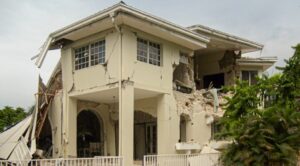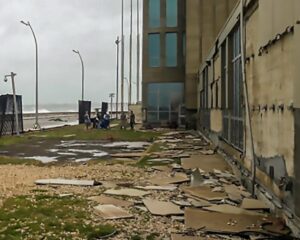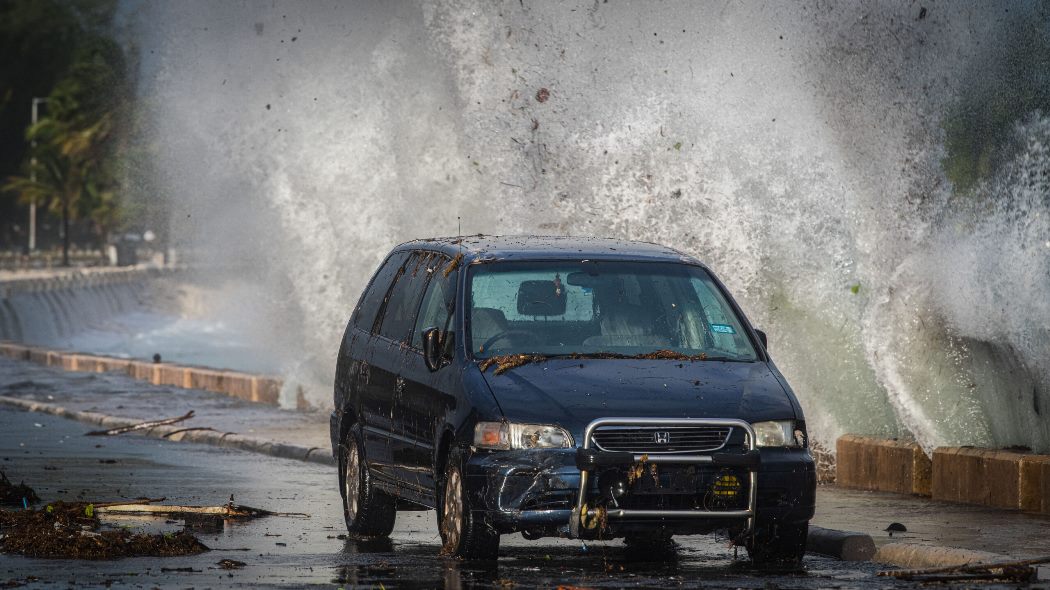Over the past 20 years, I (Storm Cunningham) have done occasional contract work for the U.S. Department of State.
Most of the work was in Poland and here in Washington, DC, although they more-recently requested my assistance in Ukraine.
In all of this time, I’d never heard of the small group you’re about to read about here, even though the nature of our work overlapped to a great extent.
**************
Located in the Bureau of Overseas Buildings Operations’ (OBO) Office of Design and Engineering, the U.S. Department of State‘s Climate Security & Resilience Program (CS&R) is a small, forward-thinking team that has evolved significantly since its inception in the 1980s.
Initially focused solely on seismic hazards, the program gradually expanded to include tsunamis, floods, extreme winds, and landslides in 2005 as the Natural Hazards Program.

Earth Hazards Lead Shane Maxemow (center) with the Ambassador Matthew Klimow (left) and Deputy Chief of Mission Andrea Brouillette-Rodriguez (right) of Turkmenistan during the 2019 Ashgabat conference. Photo by David Keller.
In 2020, the program rebranded as the CS&R Program—further expanding its focus to include extreme heat and water stress and relevant climate change-related projections.
In the last 30 years, natural hazards have resulted in 1.6 million fatalities worldwide, with economic losses estimated at approximately $300 billion per year.
The Department of State has personnel and facilities located globally, and, as such, they are exposed to natural hazards.
OBO oversees the management of the Department’s foreign real property portfolio with the mission of providing safe, secure, functional, and resilient facilities for American diplomats.
OBO manages more than 25,000 distinct assets at over 280 locations, including more than 16,000 residences and more than 900 office buildings.
The total value of the OBO portfolio is approximately $75 billion and includes more than 18,000 culturally significant objects and pieces of artwork. As the climate changes, researchers project that the severity and potential impact of natural hazards will become more pronounced.
More extreme recent heat waves in India, catastrophic wildfires in Australia and the Western U.S., and increasingly intense hurricane seasons are examples of this troubling trend.
Furthermore, the potential compounding impacts of multiple, simultaneous natural hazards necessitate multi-hazard planning (e.g. the impact of a major earthquake occurring at the same time as a dramatic heat wave, or of elevated sea levels on tsunami inundation).
Though climate security and resilience are guiding principles for all of OBO’s new construction projects—incorporated through site selection, design, and construction—some of the bureau’s existing assets in climate-vulnerable cities around the world have suffered damage from natural hazards in the past.

The 2010 earthquake in Haiti caused considerable damage to U.S. Embassy Port-au-Prince’s chief of mission residence. Photo courtesy of CS&R.
The 2010 Haiti earthquake damaged many of the Department’s residences in Port-au-Prince—although the chancery, built to OBO standards, was unharmed; and a storm surge from Hurricane Irma in 2017 damaged the embassy in Havana.
Since Department properties are exposed to natural hazards, OBO must ensure that they are resiliently constructed and maintained so that American diplomatic missions can continue, even in the wake of a disaster.
The CS&R Program aims to bring together data about the Department’s overseas portfolio and natural hazard risks. This data is considered throughout a mission’s lifecycle for overall portfolio management and specific project development.
The program emphasizes climate resilience, which means preparing missions for the impacts of natural hazards. This goal is related to, but distinct from, climate change mitigation or sustainability, which is focused on mitigating how our actions impact the environment. For example, sustainability may include increasing recycling efforts or decreasing a facility’s carbon footprint.
In contrast, climate resilience may be implemented through managed retreat to higher ground or the expansion of a drainage system to protect existing assets against worsening floods due to stronger hurricane seasons.
One of the significant achievements of the CS&R Program has been the development of a geographic information system (GIS)-based natural hazards dashboard application. This tool, implemented in 2020, inputs data into a risk screening of all Department posts around the world, helping to identify locations most exposed to natural disasters.
The dashboard application houses global-scale hazard maps for both present and future climate scenarios and uses data from sources including the World Bank, World Resources Institute, and NASA that is then overlain with OBO’s real property information.

Damage to Embassy Havana’s façade, resulting from Hurricane Irma in 2017, can be seen from the street. Photo courtesy of CS&R.
By analyzing factors such as exposure to hazards, the capacity of the community to withstand and recover from disasters, and the availability of resources for response and recovery, the dashboard application and risk screening provide valuable insights for OBO to improve the resilience of its facilities overseas and improve its global diplomatic footprint.
The CS&R Program has worked directly with embassies and ambassadors to help develop awareness and planning for natural hazards before they occur. In 2019 two members of the program traveled to Ashgabat, Turkmenistan, to partake in a multi-day conference of posts focused on emergency preparedness.
More recently, program members participated in the fall 2022 Chief of Mission conference, where they provided live demonstrations of the GIS dashboard application.
In fall 2022, CS&R also presented on the Department’s exposure to natural hazards and potential ideas for adaptation efforts at an in-service training event in Garmisch-Partenkirchen, held by OBO’s Facility Management Division for locally employed facility staff and building engineers.
Continuing projects include collaborating with the Foreign Service Institute and the Bureau of Diplomatic Security on incorporating natural hazard information into emergency action plans and developing post-specific, detailed natural hazard studies.
These detailed studies include high-resolution tsunami inundation maps and detailed flood maps that can be used in project development. Additionally, the CS&R Program is on track to complete residential seismic assessments at 35 posts in 2023.
The CS&R Program has also initiated two post-specific, multi-hazard climate adaptation pilot studies. These studies involve visiting posts selected from the global portfolio risk screening to gain greater insight into hazard exposure, further assess natural hazard vulnerabilities, and identify potential adaptation strategies. For the selected posts, the intent is to help them better prepare for and respond to the impacts of climate change.

From left: Program Manager David Keller and Natural Hazard Data Lead Julian Mancini represent their work at the Chief of Mission Conference in the Harry S Truman Building, June 2022. Photo by Kelly Dowd.
As a small developing program, CS&R leverages the technical expertise found across the government. Over the past three years, CS&R has consulted, collaborated, and formed interagency agreements with multiple agencies including the National Oceanic and Atmospheric Administration, United States Geological Survey, United States Army Corps of Engineers, USAID, and NASA.
Additionally, CS&R has been an active participant in interdepartmental working groups, including the Climate Resilience Sub Working Group and the Geospatial Data Act Working Group.
In 2021, CS&R successfully recruited its first Science and Technology policy fellow from the American Association for the Advancement of Science, with a second recruited in the 2022 cohort. These fellows provide in-house scientific expertise on natural hazards, volcanoes and wildfires, respectively, and work on developing natural hazard-focused office policies.
The CS&R Program is a necessary resource for the Department, helping to enhance the safety and security of American diplomats and posts worldwide.
By staying up-to-date on the latest research and technologies, the program provides vital guidance on understanding and adapting to the increasingly complex challenges posed by natural hazards and the compounding impacts of climate change.
With the launch of the natural hazard GIS dashboard application, the risk screening, and the start of post-specific climate adaptation surveys, the CS&R Program is at the forefront of efforts to promote climate security and resilience within the Department.
Featured photo (by Isaac D. Pacheco) shows storm surge from then-Tropical Storm Nicole as it slams against the seawall on Junkanoo Beach in Nassau on November 9, 2022.
This article by Dr. Cassandra M. Smith—a volcanologist and Science and Technology policy fellow in the Climate Security & Resilience Program—originally appeared on the State magazine website of the U.S. Dept. of State. Reprinted here by permission.

